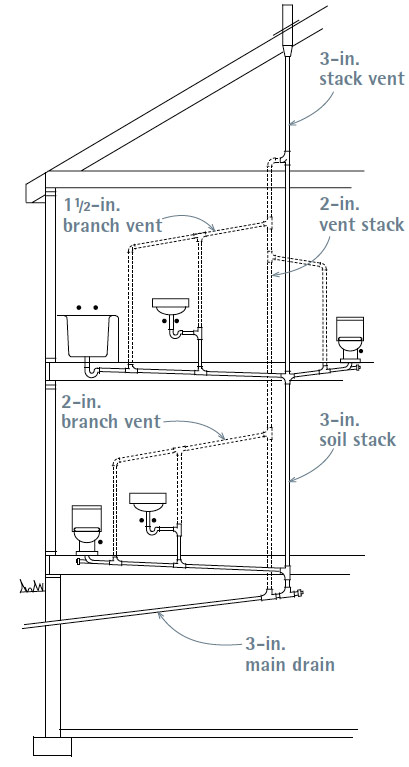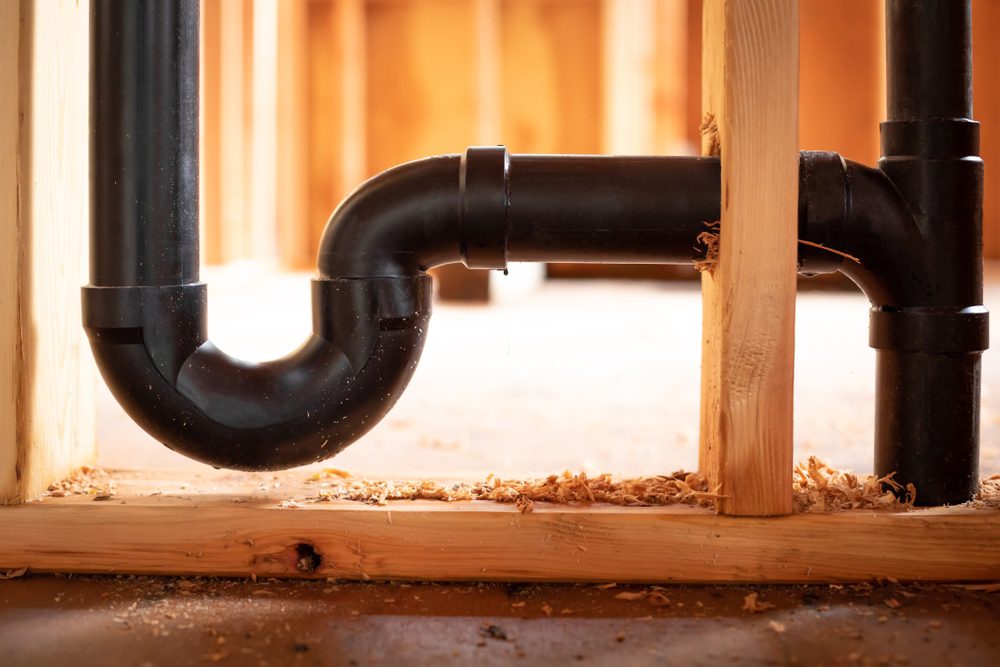Key Reasons for Proper Ventilation in Plumbing Systems
Key Reasons for Proper Ventilation in Plumbing Systems
Blog Article
What are your concepts about What Is a Plumbing Vent and Why Is It Important?

Appropriate ventilation in plumbing systems is frequently ignored, yet it is critical for maintaining the functionality and safety and security of your home's plumbing. Air flow aids manage air pressure, avoid the accumulation of dangerous gases, and ensure the reliable elimination of waste. In this guide, we will certainly explore the significance of correct pipes air flow, exactly how it functions, and the advantages it offers your pipes system.
Recognizing Air Flow in Pipes
Air flow in pipes describes the network of pipelines that enable air to flow via the drainage system. These vents offer several functions, consisting of regulating air pressure within the pipes, protecting against sewage system gases from entering the home, and assisting in the smooth circulation of wastewater.
Just How Air Flow Works in Plumbing Solutions
Air Pressure Policy
Proper air flow preserves balanced atmospheric pressure within the plumbing system. When water streams through pipelines, it displaces air. Without adequate ventilation, this variation can produce adverse pressure, bring about slow drains or siphoning of water from traps, which can trigger undesirable odors to seep into the home.
Preventing Sewage System Gas Accumulation
One of one of the most critical features of plumbing vents is to avoid sewer gases, such as methane and hydrogen sulfide, from building up within the home. These gases can position serious health threats and are highly flammable. Vent pipelines enable these gases to get away safely outside.
Aiding in Waste Removal
Air flow helps in the effective elimination of wastewater by stopping airlocks in the drainage system. When air can flow freely via the vents, it allows water and waste to flow efficiently through the pipelines, decreasing the risk of obstructions and back-ups.
Kinds Of Pipes Vents
Main Heap Vent
The main stack vent, likewise called the air vent stack, is the main air vent in a pipes system. It prolongs from the major drainpipe line up through the roofing, allowing gases to run away and fresh air to get in the system.
Branch Vent
Branch vents connect to the major stack air vent and offer private components, such as sinks, toilets, and showers. These vents guarantee that each fixture has adequate air flow to function effectively.
Air Admission Valve (AAV).
An Air Admittance Valve (AAV) is a one-way valve that allows air to enter the pipes system without the requirement for a conventional vent pipeline prolonging through the roofing system. AAVs are typically utilized in remodellings or areas where installing a conventional air vent is impractical.
Indicators of Poor Ventilation in Pipes.
Slow Draining Fixtures.
If your sinks, tubs, or toilets are draining pipes slowly, it could be a sign of poor ventilation. Poor air flow can produce a vacuum cleaner result, making it challenging for water to drain pipes appropriately.
Gurgling Seems.
Gurgling noises originating from drains are frequently a result of air being drawn via water traps because of adverse stress in the pipelines. This is a clear indication of not enough ventilation.
Undesirable Odors.
Sewage system smells inside your home are a red flag that your pipes system is not properly ventilated. This could indicate that sewage system gases are not being sufficiently vented outside, resulting in possibly harmful problems.
Typical Air Flow Mistakes.
Poor Vent Sizing.
Using small vent pipes can cause inadequate air flow and pressure imbalances in the system. It's important to utilize vents that fulfill the details requirements of your plumbing system.
Improper Vent Placement.
Placing vents also far from the components they offer can lower their performance. Correct placement guarantees that air can flow easily and effectively with the system.
Ignoring Code Needs.
Building codes offer particular guidelines for plumbing air flow. Ignoring these codes can result in a system that fails to function properly and may cause pricey fixings or health hazards.
Advantages of Correct Air Flow.
Improved System Performance.
Properly ventilated pipes systems operate a lot more efficiently, with less obstructions, faster draining, and much less strain on the pipes. This efficiency extends the life expectancy of the plumbing system.
Improved Air Quality.
By preventing sewer gases from entering your home, proper air flow adds to better interior air quality, making your living environment healthier and a lot more comfy.
Stopping Water Damage.
Appropriate air flow helps avoid water from being siphoned out of catches, which can result in sewage system gases getting in the home and creating water damages with time.
Actions to Ensure Appropriate Air Flow.
Consulting Pipes Codes.
Constantly seek advice from regional plumbing codes when creating or modifying your plumbing system. These codes give the required guidelines for appropriate airing vent and ensure your system satisfies safety and security requirements.
Regular Inspection and Maintenance.
Regular inspections can aid recognize possible air flow problems before they end up being major problems. Upkeep tasks, such as cleansing vent pipes and looking for blockages, are important for maintaining the system in good working order.
Expert Setup.
For new installations or major modifications, it's important to employ a specialist plumbing. They have the know-how to make sure the air flow system is properly designed and mounted according to code.
Verdict.
Proper air flow is a vital component of any pipes system, guaranteeing that it functions successfully and safely. By recognizing the importance of air flow, recognizing the indications of inadequate ventilation, and taking actions to maintain your system, you can stop expensive problems and safeguard your home's air high quality.
4 Things You Should Know About Your Plumbing Vents
What Plumbing Vents Are
Also called a vent stack, a plumbing vent is a vertical pipe attached to your drain line that runs through your roof. The plumbing vent pipe, or plumbing air vent, removes gas and odors from your plumbing system and allows fresh air to enter the pipes, helping the water to flow out of the drain pipes.
What Plumbing Vents Do
Plumbing vents have two basic functions. One of which is to allow unpleasant smelling wastewater and sewer gasses to escape your plumbing system instead of entering your home. Plumbing vent pipes are typically located on roofs, away from windows, to ensure the fumes exit the home completely.
The other function of the plumbing vent is to move fresh air into your plumbing system. This helps move water through every plumbing fixture in your house, like toilets and sink drains. Think of the way in which you need to let a little air into the bottle as you pour soda in order to make the drink flow smoothly.
Different Types of Plumbing Vents
True vent: This is the most common vent option. In simplest terms, a true vent is a vertical pipe attached to your drain line that exits through the roof. They often function as the main vent that other fixtures can connect to. Re-vent pipe or auxiliary vent: Attached to the drain line near specific plumbing fixtures, re-vent pipes run up and over to connect to the main vent. Common vent: Two plumbing fixtures installed on opposite sides of a wall are typically tied into the vent stack using something known as a sanitary cross. Wet vent: This venting option operates as a drain pipe and a vent at the same time. Wet vent drainage systems drain water from one fixture while venting the air from another. Although they’ve been used for over 100 years, wet vent systems have only recently been added to the plumbing code in many areas. If you’re planning on installing one in a bathroom remodel, make sure you check your local code prior to construction. Loop vent: For free-standing fixtures like kitchen island sinks, loop vents are ideal. These vent pipes run under the floor, rise from the P-trap, and create a loop inside the cabinet sink. Air admittance valve: An AAV is a one-way mechanical valve typically installed at the site of the plumbing fixture. AAVs allow venting to occur without having to tie into a larger venting system. They’re ideal for venting fixtures where you aren’t able to easily connect to an existing vent system. Common Plumbing Vent Issues
Although vent pipes typically don’t have water flowing through them, they’re still subject to many typical plumbing issues. For example, clogs are one of the most common problems associated with sewer vent pipes. If your vent pipe gets clogged, all of your plumbing fixtures tied into the vent stack will be affected.
A sink with a slow drain that bubbles and gurgles or a strong sewage smell around your toilet are both indicators that your toilet vent pipe is clogged. Because most vent pipes exit through the roof, old leaves, twigs or even a bird’s nest could be clogging the pipe.
Clogs in your vent pipe system cause a buildup of negative pressure, meaning that water won’t be able to flow out of your home very well. It’s similar to putting your finger over the opening of a straw to trap water inside. When you remove your finger, the water is able to flow out of the straw.
If you suspect you have any blockage in your vent, make sure you have a professional come examine the situation. Left unchecked, a blocked air vent can lead to other costly repairs, like leaks and sediment buildup.
Under Pressure
Pipe vents are essential aspects of a home’s plumbing system. Owning a home means learning about all sorts of things you never put much thought into before. But by understanding as much as you can about the important systems of your home, you can keep those budgets intact and those anxiety levels low.
https://www.homeserve.com/en-us/blog/home-improvement/plumbing-vents/

Hopefully you enjoyed our section about What Is A Plumbing Vent & How Do They Work?. Thanks a ton for taking the time to read through our short article. Be sure to take a moment to share this page if you liked it. Thanks for being here. Revisit us soon.
Click Here Report this page